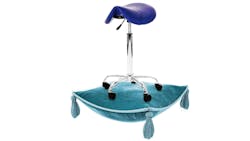Saddle stools: Finding that perfect fit
There has been a rise in both awareness and usage of saddle stools among dental practitioners in recent years. Although information about saddles is widely available, it is often difficult for professionals to find a stool that supports their body and their career in all the necessary ways.
The daily work dental professionals perform can cause a large amount of strain on the body. While the percentages of dental professionals in pain varies across studies, they consistently show that 80%–96% of dental professionals experience work-related pain in their careers.1 While many hygienists believe that we are destined to experience career-related pain and injuries, there are many ways to decrease the risk, starting with the chair we use. Most often, a clinician will select their stool based on a few simple factors: it was in the room when they got there, it was picked by someone else, or someone recommended it to them. Although these may be the easiest reasons to select a stool, they are not always the most effective. But when clinicians spend eight hours a day in a chair that doesn’t provide adequate support, it tends to lead to many long- and short-term health issues.
Related reading:
- You've got a saddle seat. But how does it work?
- Saddle stools: Don’t buy until you try
- Saddle seating: Choosing the right design for the right reasons
For years, dental practitioners used traditional seating, and prior to the introduction of saddle stools, many clinicians used the same style and shape of chairs. The problem with this is that practitioners come in different shapes and sizes: tall, short, thin, broad, long legs, short legs, etc. Because of the design of most traditional chairs, and the fact that every practitioner needs different structure and support, these chairs don’t support the bulk of clinicians properly.2
Ergonomics is about designing a job to fit the worker, not forcing the worker to fit a workplace.3 With this in mind, all tools and equipment used should be designed to adapt to the user.4 This includes the clinician’s chair. Using a properly made and fitted stool will allow for increased productivity, an easier workflow, and reduced risk of injury in the dental office.
Both from a design and functionality perspective, saddle stools are different than traditional chairs used in dentistry. Saddle stools allow the practitioner to maintain an upright spine, supporting a neutral posture while practicing. Additionally, saddle stools allow the practitioner to move closer to the patient, minimizing the need to reach forward or lean to one side. When sitting in an upright position consistently, several things happen. First, the user is more frequently activating their core and back muscles, which leads to a better sense of stabilization in and out of the op. Second, the natural curvature of the spine is promoted, which often leads to a better balance between the intervertebral discs. Finally, there is a reduction in shoulder tension and forward head carriage as the user’s body is required to hold less weight than it would in a slouched-over position.2,5-8
Although the benefits of utilizing a saddle stool are apparent, getting the right stool is key to long-term success. It is crucial that a clinician gets a stool that promotes overall health and reduces musculoskeletal strain.6,8
Size matters
The most common question I receive from hygienists is, “Which saddle stool should I get?” While that’s a relatively simple question, the answer is more complex. As discussed previously, each body is different, and every practitioner should find a saddle that fits their unique body size and type. That’s why my answer is consistently, “It depends.”
There are five factors every practitioner should consider when picking out their saddle. These factors are pelvic width, torso size, leg length, height, and hip flexibility. All of these factors play a role in helping clinicians find their glass-slipper saddle.
The first factor to consider is pelvic width. Pelvic width is used to determine the proper size, shape, and design of the stool for the user. Clinicians should find a seat pan that fully supports their thighs and buttocks and feels comfortable through the hips. There are many different styles to choose from based on your needs. For example, a wider-style saddle stool may not feel comfortable for a clinician with narrow hips, as they’d be better supported by a narrow saddle that keeps their legs closer together, and vice versa.
Other factors to consider include leg length, or inseam, and the user’s height, which determines the size of the cylinder. Two people who are the same height don’t always buy the same size jeans; one person may have longer legs and a short torso, and the other may have shorter legs and a long torso. So, just as there is more than one measurement in finding the right fit for jeans, the same is true for saddles.
The next two components help determine the size of the seat and the cylinder, which allows the saddle to go up and down. The weight and size of the clinician’s torso are important, because we want to make sure the stool supports their weight and allows them to practice within their full range. The last factor to consider is the clinician’s hip flexor muscles. A clinician with tighter hip flexor muscles will likely be uncomfortable with a saddle design that forces the legs apart into a tripod; they'll find more support with a narrower design that keeps the legs closer together. The same is true on the other end of the spectrum.
While it may seem daunting to consider so many factors when investing in a saddle stool, career longevity is the goal. So, as many ergonomic specialists in the dental world have said before, it’s crucial to use the Goldilocks approach—find the one that’s “just right” for you.
Quality over quantity
On one side of the coin, dental practitioners are fortunate to have an abundance of saddle stool options compared to what was available 10 years ago. You can purchase a saddle stool by looking through a catalog in your office, attending an event, or with a quick Google search. The options are endless! On the other side of the coin, however, there are so many saddles available that it is often hard to identify which saddle is right for you. There are many variances in the shape, size, design, and overall quality of each product. For long-term health and career longevity, it’s vital for every practitioner to make an educated decision based on their needs.
One of the most important features for a saddle itself, outside of the personalized build, is the ability to adjust seat pan tilt. Being able to tilt the seat pain forward and backward allows each practitioner to make small adjustments to maintain neutral posture positioning, as well as adjust with different patients or throughout a procedure as needed. This feature is not available with all saddle stools.
While there are many saddle stool companies out there, the quality of the product varies greatly. There is a big difference between a basic, inexpensive saddle stool sold online and one that is designed specifically for the needs of a dental practitioner to accommodate the dental operatory. Typically, basic saddles on the market don’t fit the user correctly, can’t be adjusted properly, and often don’t hold up well over time. As with most things, you get what you pay for. A good saddle stool is well designed, clinician-specific, and created for the dental operatory. There are a few notable brands on the dental saddle market worth considering, including Crown Seating, Brewer Company, and RGP.
Finding your glass slipper
For many reasons, a saddle stool can greatly decrease the risk of pain and injury for dental practitioners.9 However, we now know that it’s not as simple as looking on a website, finding one with the right esthetic, and making the purchase. There are many factors to consider.
The perfect saddle stool is an investment, and a good first step in finding your glass slipper is to try out a few. Start by testing different shapes and sizes. Notice how they feel after you sit in a neutral position for a few minutes. Your "glass slipper" should feel comfortable and supportive when adjusted properly. Typically, you can try out stools directly through your dental supply company, or through the saddle company itself. Another great way to test saddles is to attend a dental event or convention. Bring your loupes, try some saddle stools, and see how they feel. Finding the one for you may take time and research, but it’s worth it.
After purchasing a saddle, you’ll want to learn how to adjust it to obtain and maintain neutral posture. Similar to purchasing new loupes, there may be an adjustment period. If you get frustrated, be sure to troubleshoot with an ergonomics professional—don't give up! Finding an ergonomically sound saddle stool that you know how to use properly will help you practice safely, comfortably, and effectively, supporting a long-lasting career. As dental hygienists, our body is our greatest tool—that’s why finding your glass slipper saddle stool will pay off tenfold.
Editor’s note: This article appeared in the June 2023 print edition of RDH magazine. Dental hygienists in North America are eligible for a complimentary print subscription. Sign up here.
References
- Saccucci M, Zumbo G, Mercuri P, et al. Musculoskeletal disorders related to dental hygienist profession. Int J Dent Hyg. 2022;20(3):571-579. doi:10.1111/idh.12596
- Pope MH, Goh KL, Magnusson ML. Spine ergonomics. Annu Rev Biomed Eng. 2002;4:49-68. doi:10.1146/annurev.bioeng.4.092101.122107
- Ergonomics. U.S. Department of Labor. Occupational Health and Safety Administration. Accessed January 10, 2021. https://www.osha.gov/
- Guignon A. Saddle seating: choosing the right design for the right reasons. RDH. May 2022. Accessed January 23, 2023. https://www.rdhmag.com/ergonomics/article/14235048/saddle-seating-choosing-the-right-design-for-the-right-reasons.
- Gao Y, Cronin NJ, Pesola AJ, Finni T. Muscle activity patterns and spinal shrinkage in office workers using a sit-stand workstation versus a sit workstation. Ergonomics. 2016;59(10):1267-1274. doi:10.1080/00140139.2016.1139750
- Gouvêa GR, Vieira WA, Paranhos LR, Bernardino ÍM, Bulgareli JV, Pereira AC. Assessment of the ergonomic risk from saddle and conventional seats in dentistry: a systematic review and meta-analysis. PLoS One. 2018;13(12):e0208900. doi:10.1371/journal.pone.0208900
- Thorp AA, Kingwell BA, Owen N, Dunstan DW. Breaking up workplace sitting time with intermittent standing bouts improves fatigue and musculoskeletal discomfort in overweight/obese office workers. Occup Environ Med. 2014;71(11):765-771. doi:10.1136/oemed-2014-102348
- Gandavadi A, Ramsay JR, Burke FJ. Assessment of dental student posture in two seating conditions using RULA methodology - a pilot study. Br Dent J. 2007;203(10):601-605. doi:10.1038/bdj.2007.1047
- Dylla J, Forrest JL. Fit to sit—strategies to maximize function and minimize occupational pain. J Mich Dent Assoc. 2008;90(5):38-45.
About the Author

Caitlin Parsons, RDH, C-IAYT, CEAS
Caitlin Parsons, RDH, C-IAYT, CEAS, is a practicing dental hygienist, yoga therapist, ergonomics expert, and the founder of The Aligned Hygienist. She is a writer, public speaker, consultant, podcast host, and content creator. Caitlin specializes in ergonomics, yoga therapy, pain prevention, stress management, and burnout for dental professionals, teams, and organizations. Contact her at [email protected].
